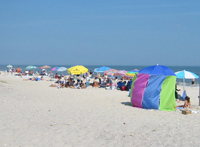 |
 | |
  | |
|
|
|
|
Fire Island National Seashore
For Your Safety: Protect Yourself From Sun
|
|
|
|
|
| |
 |
 |
| Many sunbathers bring an umbrella or sunshade, but be prepared to carry all your beach gear from the ferry and back again. |
 |
Be sure you're protecting yourself and your children from the sun. The sun's rays reflect off the water and can cause long-term damage to your skin and eyes. You should apply appropriate sunscreen, even on cloudy days.
Remember to reapply after swimming. Wear or carry with you a lightweight long-sleeved shirt or cover-up and a hat for additional sun protection. Don't forget to cover or apply sunscreen to the tops of your feet, especially if you're strolling down the beach!
Wear quality sunglasses with 100% UV protection to protect your eyes. Beach umbrellas are recommended, but you'll have to carry them on and off the island with you. At this time, umbrella rentals are not available at Fire Island National Seashore beaches.
Drink plenty of water or sports drinks on hot days to avoid dehydration. Remember that caffeine and alcohol can dehydrate your body, so drink fluid that will hydrate you whenever you're in the sun.
Fire Island's cool breezes often temper the effects of summer heat. However, you should recognize the signs of common —heat stroke, heat exhaustion, heat cramps, sunburn, and heat rash—and take proper precautions to protect yourself.
|
|
For More Information
 Preventing Preventing
 Dealing with Dealing with
 National Weather Service National Weather Service
|
|
|
|

Swim at Protected Areas
Lifeguarded beaches are located at Watch Hill and Sailors Haven.
more... | | 
Check Today's Forecast
Link to local weather and tides.
more... | |
|
|
|
|
|
|
|
 |
|
Did You Know?
Horseshoe crabs come near shore on the full moon in May and June to lay thousands of eggs, which are a valuable food source for migrating shorebirds in spring and early summer. Occasionally, a perfectly-formed horseshoe crab molt can be found on the beach, shed as the young animal grows.
more...
|
|
|
|
Last Updated: December 05, 2006 at 23:48 EST |









